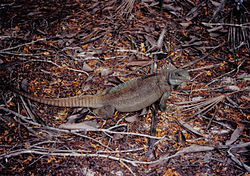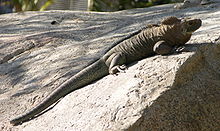- Turks and Caicos rock iguana
-
Turks and Caicos Rock Iguana 
Conservation status Scientific classification Kingdom: Animalia Phylum: Chordata Class: Sauropsida Order: Squamata Suborder: Iguania Family: Iguanidae Genus: Cyclura Species: C. carinata Binomial name Cyclura carinata
(Harlan, 1825)The Turks and Caicos rock iguana (Cyclura carinata) is a critically endangered species of lizard of the genus Cyclura that is endemic to the Turks and Caicos islands. Turks and Caicos has 50,000 rock iguanas, the healthiest population of rock iguanas in the Caribbean.
Contents
Taxonomy
The Turks and Caicos rock iguana, Cyclura carinata carinata, was first described by American Zoologist Richard Harlan in Fauna Americana in 1825.[1] Its generic name (Cyclura) is derived from the Ancient Greek cyclos (κύκλος) meaning "circular" and ourá (οὐρά) meaning "tail", after the thick-ringed tail characteristic of all Cyclura.[2] Its specific name carinata means "keeled" and refers to the animal's scales. The species is endemic to 50-60 of the 200 islands and cays that make up the Turks and Caicos Islands.[3] It has one subspecies which lives on Booby Cay, Bartsch's iguana (Cyclura carinata bartschi).[3][4] Morphological and genetic data indicate that the closest living relative of C. carinata is C. ricordi of Hispaniola.[5]
Anatomy and morphology
Measuring less than 770 mm in length when full grown, the Turks and Caicos Rock iguana is one of the smallest species of Cyclura.[6][7] The lizard's basic color can range from green to brownish grey, usually patterned by darker markings.[3] The species lacks the large scales on the upper surface of its head, characteristic of other species of cyclura and possesses larger dorsal spines than other species of iguana.[8]
Like other members of the genus cyclura, males of this species are larger than females(in this case twice as large in body mass) and have larger dorsal crests and femoral pores on their thighs making the animals sexually dimorphic.[9][10]
Habitat and distribution
The Turks and Caicos rock iguana inhabits small cays, but has been reduced to less than 5% of its original range largely due to the introduction of predators.[6][8]
2,000 iguanas are the only land creatures that inhabit Little Water Cay.[8] To promote tourism on Little Water Cay, a boardwalk has been built throughout the island.[5] Tourists can take a tour of the island, along this boardwalk, but are not permitted to step off it.[5][8]
The Turks and Caicos rock iguana dwells in rocky areas and sandy habitats as sand is required for nesting.[5][11] The Turks and Caicos iguana is diurnal and spends the night in the burrows it has dug or in natural retreats in or under the rocks.[11]
Diet and longevity
Like all Cyclura species, the Turks and Caicos rock iguana is primarily herbivorous, consuming leaves, flowers, and fruits from over 58 different plant species.[3] This diet is very rarely supplemented with insects, mollusks, crustaceans, arachnids, lizards, and carrion.[11] It has been noted that in captivity, it eats both animal and plant food.[5][11] Gerber and Iverson write that the Turks and Caicos rock iguana may live at least 20 years.[11]
Mating
Adult males are sexually mature at seven years of age and are territorial throughout the year in order to guarantee access to food and females.[11] Females only become territorial when defending their nest site upon laying eggs and for several weeks following.[11] The animals mate in May, and the female lays a single clutch of two to nine eggs in June.[11] The eggs hatch in September after a 90-day incubation period.[11]
Causes of decline
Like most Cyclura species the Turks and Caicos rock iguana is in decline. In this species' case it is primarily due to its small body size which makes it vulnerable to introduced predators such as dogs and cats.[3][6] In the 1970s a population of 15,000 iguanas was completely destroyed within five years by a mere handful of dogs and cats brought to Pine Cay by hotel workers.[6] Competitive grazing with domestic and feral livestock is a secondary factor.[3][12]
Conservation measures
Although Little Water Cay is home to over 2,000 Turks and Caicos rock iguanas, they have been wiped out from the other cays in their former range.[3][8] Little Water Cay is now a nature reserve and neither dogs nor cats are permitted on the island to ensure the survival of the critically endangered species.[3]
In 2000 scientists from the San Diego Zoo's division of Conservation and Research for Endangered Species (CRES), under the direction of Conservation Research Fellow Dr. Glenn Gerber translocated 218 iguanas from Big Ambergris and Little Water Cay where their populations were threatened to four uninhabited cays within the Turks and Caicos reserve system.[6][13]
To date, these iguanas have experienced a 98 percent survival rate; they have adapted to new conditions and even successfully reproduced the immediate breeding season.[6][13] Yearling iguanas resulting from the reproduction of the original translocated adults from 2002 are exceeding the size of their counterparts on the source Cays from which their ancestors were translocated by as much as 400%.[6][13]
Legislation to protect the iguanas has been drafted by the Turks and Caicos government in 2003.[6] Additionally, the National Trust for the Turks and Caicos Islands has stewardship for the Little Water Cay to ensure that it is not mismanaged and has initiated a program to remove feral cats from Pine Cay and Water Cay.[3]
References
- ^ "Cyclura carinata Harlan, 1825", Integrated Taxonomic Information System, 2001, http://www.itis.gov/servlet/SingleRpt/SingleRpt?search_topic=TSN&search_value=202147, retrieved 10/5/2007
- ^ Sanchez, Alejandro. "Family Iguanidae: Iguanas and Their Kin". Father Sanchez's Web Site of West Indian Natural History Diapsids I: Introduction; Lizards. Kingsnake.com. http://www.kingsnake.com/westindian/metazoa10.html. Retrieved November 26, 2007.
- ^ a b c d e f g h i Gerber (2004). Cyclura carinata. 2006. IUCN Red List of Threatened Species. IUCN 2006. www.iucnredlist.org. Retrieved on 11 May 2006.
- ^ Hollingsworth, Bradford D. (2004), "The Evolution of Iguanas: An Overview of Relationships and a Checklist of Species", Iguanas: Biology and Conservation (University of California Press): pp. 35, ISBN 9780520238541
- ^ a b c d e Alberts, Allison (2007), "Turks & Caicos Iguana, Cyclura carinata carinata Conservation & Mgmt. Plan 2005 - 2009" ([dead link]), Iguana Specialist Group, http://www.iucn-isg.org/recoveryplan/dnld1.php?application=application/octet-stream&fileName=TCI-CAMP-4July2007_Sml.pdf, retrieved 2007-10-22[dead link]
- ^ a b c d e f g h Hudson, Rick (4/1/2007), "Big Lizards, Big Problems", Reptiles Magazine 15 (4): 54–61
- ^ Hudson, Richard D.; Alberts, Allison C. (2004), "The Role of Zoos in the Conservation of West Indian Iguanas", Iguanas: Biology and Conservation (University of California Press): pp. 281–285, ISBN 9780520238541
- ^ a b c d e Welch, Mark E.; Gerber, Glenn P.; Davis, Scott K. (2004), "Genetic Structure of the Turks and Caicos Rock Iguana and Its Implications for Species Conservation", Iguanas: Biology and Conservation (University of California Press): pp. 58–70, ISBN 9780520238541
- ^ De Vosjoli, Phillipe; David Blair (1992), The Green Iguana Manual, Escondido, California: Advanced Vivarium Systems, ISBN 74886904040
- ^ Martins, Emilia P.; Lacy, Kathryn (2004), "Behavior and Ecology of Rock Iguanas,I: Evidence for an Appeasement Display", Iguanas: Biology and Conservation (University of California Press): pp. 98–108, ISBN 9780520238541
- ^ a b c d e f g h i Gerber, Glenn; Iverson, John (2005), "Turks and Caicos Iguana", World Conservation Union Iguana Specialist Group (IUCN-ISG), http://www.iucn-isg.org/actionplan/ch2/tciguana.php, retrieved 10/5/2007
- ^ Hayes, William K.; Carter, Ronald L.; Cyril, Samuel; Thornton, Benjamin (2004), "Conservation of a Bahamian Rock Iguana, I; Iguanas: Biology and Conservation", Iguanas: Biology and Conservation (University of California Press): pp. 245, ISBN 9780520238541
- ^ a b c "Turks and Caicos Iguana Restoration Program" ([dead link]), Conservation and Research for Endangered Species, 2007, http://cres.sandiegozoo.org/projects/sp_turks_caicos_iguanas.html
External links
Iguanidae Kingdom: Animalia · Phylum: Chordata · Class: Sauropsida · Order: Squamata
Wikimedia Foundation. 2010.


